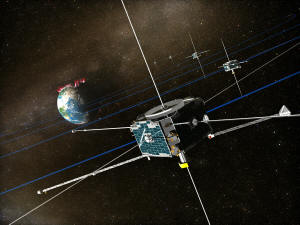|
12/17/2007 from Thunderbolts Website
The day of this writing, December 13, 2007, is the 140th anniversary of the birth of the Norwegian-born physicist Kristian Birkeland.
It was Birkeland who correctly hypothesized in the early 20th century that electric currents from the Sun power the earth's auroras.
For many decades, the scientific mainstream largely rejected Birkeland’s thesis, favoring instead the idea that Earth's magnetosphere is an impenetrable envelope, "squeezed" by the solar wind to induce auroral activity.
Only when satellites detected the magnetic signatures of electric
currents in the aurora in 1973 was Birkeland's hypothesis
irrefutably validated - though for another two decades many
astronomers resisted the implications of this discovery.
Yet a
full century later, astronomers continue to be mystified by these
phenomena in space. (To see Birkeland's observations on the
electrical properties of comets, published in 1913, read "Comets
- Kristian Birkeland's theory").
That is
because they still cling to theoretical models that conceptually
exclude the possibility of electrical circuits in space - even when
their models are refuted by new observations that they characterize
(and sometimes discard) as "impossible."
Themis Spacecraft Launch
The report discusses the THEMIS spacecraft's recent observations of,
Describing the THEMIS encounter with a "magnetic rope" NASA investigator Dave Sibeck states:
Investigators observed that the so-called rope,
Magnetic "ropes"?
This expression begs the question of how the fluid dynamics envisioned by NASA can explain a "rope-like" structure that twists and changes dynamically, and extends all the way from Earth back to the Sun. NASA scientists often use the phrase "flux ropes" to describe these twisted filamentary pathways traversed by charged particles.
But to electrical engineers, such terminology reveals a deep confusion among astronomers struggling to comprehend unexpected electrical activity.
Professor Donald E Scott, author of The Electric Sky, says,
The "ropes" to which the investigators refer are commonly described in plasma science as electrical "Birkeland currents," named after the aforementioned Kristian Birkeland.
The rope-like structure is not just a curiosity; it is the structure taken by current flow due to the long-range attraction and short-range repulsion between current filaments.
The "twisted magnetic
fields" are simply the signature of the electric current flow. In
plasma cosmology, these entwined plasma filaments act as
transmission lines carrying "field-aligned" currents across
interplanetary and interstellar space.
The term describes an electric current in a space plasma. It is this function of plasma filaments that inspires Electric Universe proponents to assert,
However, the term "Birkeland
current" has never been included in the mainstream astronomical
lexicon. Only in recent years have astronomers begrudgingly
entertained the concept when evidence has allowed for no
alternative.
The surprises for investigators began in March, when,
The report reads:
The storm had traversed an entire polar time zone in 60 seconds flat!
The energy of this two-hour outburst - five hundred thousand billion Joules - is roughly the energetic equivalent of a 5.5 magnitude earthquake. In trying to discern "where does all that energy come from?"
NASA is left groping
for explanations.
The NASA report describes the "magnetic ropes" (electrical Birkeland currents) observed by THEMIS as,
This description is
colorful and poetic, but does it amount to a scientific explanation?
Left unanswered is, how are the ropes created, and why do they
twist?
Using such language to describe the electrical currents and powerful discharges from solar energy replaces the language of advanced plasma science with the mechanical language of wind and water.
Nowhere does the report
mention the explosive potentials of the "double-layer," a structure
common to all plasma sheaths - the cellular strictures, such as
Earth’s magnetosphere, around charged objects in a plasma.
The irony here is that by clinging to gravity-only dogma ("no electricity in space"!) - a dogma codified before we had the tools of modern plasma science - mainstream astronomy has obstructed the path of scientific progress pioneered by Kristian Birkeland a century ago.
|

